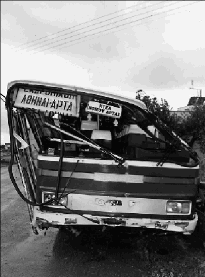Drivers are advised to arrive at the port at least an hour before their ferry is due to depart and to comply with the directions of port officials responsible for supervising onshore traffic in the port.
By Dora Antoniou/Kathimerini Newspaper
Road to hell. The number of accidents on the roads has risen by nearly 18 percent in the last decade as the number of cars circulating has increased. Fortunately, the number of fatalities and serious injuries has remained even over that time.
The
inhabitants of Attica who have fallen victim to fatal road accidents over the
past 10 years (5,000) could easily populate a small town, according to data by the Statistics Bureau
of the Attica Traffic Police.
could easily populate a small town, according to data by the Statistics Bureau
of the Attica Traffic Police.
Specifically, 4,940 people were killed and 8,844 seriously injured in road accidents from 1991 to 2000, with 124,194 more in the same period suffering minor injuries.
In total, a rise in road accidents of 17.58 percent was recorded over the past decade, from 9,976 in 1991 to 11,730 in 2000. The number of fatal accidents and deaths shows little variation from year to year.
However, 1994 had the lowest recorded number of fatal accidents. On the other hand, serious injuries show a rise of 22.12 percent in the year 2000 against 1991, a rise matched by minor road accidents, and the number of less serious injuries showing an increase of 15.43 percent for 2000 as compared to 1991.
The majority of accident victims are male. Out of 509 fatalities in 2000, 398 were men and 111 women. Out of the 1,209 seriously injured in the same year, 932 were men and 277 were women, while 9,475 men and 3,979 women suffered minor injuries.
Of the 482 fatal accidents which took place in Attica in 2000, only 40 took place on the national roads towards Lamia and Corinth. Generally speaking, traffic police officers noted that national roads had the lowest accident rate, due to the fact that the roads are in better condition and that drivers tend to use more care on them. (Harry says 'BS'!)
Pedestrians were the largest group of those killed in road accidents in 1996.
A breakdown of the figures gives us 198 pedestrians killed as compared to 139 car occupants and 14 motorcycle riders out of a total of 501 fatalities. This tendency was reversed only after 1998, when the number of car passengers killed overtook both that of pedestrians and motorcycle riders.
For example, in 2000, pedestrians accounted for 176 of all fatalities as opposed to 198 for vehicle occupants and 135 motorcycle riders.
As expected, the vast majority of accidents involved private cars (amounting to 57 percent), while motorcycles, mopeds, trucks and other vehicles (buses and bicycles) accounted for 25 percent, 7 percent, 7 percent and 4 percent of accidents respectively.
Most accidents in 2000 happened on a Thursday. In the five-year period between 1996 and 2000, however, Friday was the worst day for accidents. Both in the last five years and in 2000, the peak time for accidents was the same - from 5.00 to 9.00 in the evening. As traffic police officers note, tiredness is the major cause since these are the times when most drivers are returning from work. Of the entire year, June is the most dangerous month for accidents.
The years 1996 to 2000 saw a total of 71,462 accident victims, of whom 13,255 were over 50. The 18 to 29 age group accounted for nearly half of all victims, 30,397 individuals in all. These figures (see graph) clearly show the heavy price paid by this age group. The over-50s also form a large proportion of all accident victims.